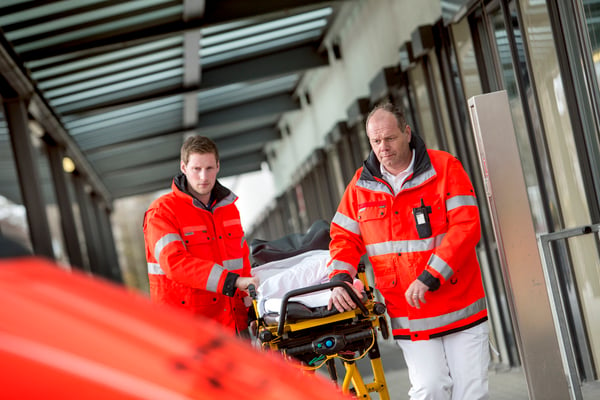During challenging times, secure and reliable communications in healthcare can improve operational efficiency and response times significantly. However, all the procedures must be planned beforehand in order to be ready to apply them immediately when needed.
Preparedness for crisis and disasters
Preparedness, or readiness, is built by analysing potential threats, defining concrete set of actions to take, ensuring availability of essential goods and materials (such as medicines, protective gear, gasoline etc.), training people and then last, but not least, practicing the implementation of the plans and procedures. Preparedness is often invisible to the general public. However, it requires proper planning and continuous training. When the crisis is on, there is no time for rehearsals. The focus should be on actions and execution, not on learning.
Readiness typically aims to mitigate negative effects of accident, epidemic or other disastrous event and minimize loss of life, injury and damage to economy and property. Besides responding to a crisis situation, it is also necessary to sustain essential services despite the extra stress placed on resources because of the crisis. After all, the everyday medical emergencies keep on appearing also during crisis.

A successful response to a crisis typically requires multi-authority cooperation and good situational awareness. An effective coordination and command chain requires an effective communication across organizational boundaries, often also over wide area and regardless of devices and networks in use. Preferably, a crisis response should be based on the same procedures, tools and methods as in day-to-day operations.
Disaster Response and Communication
Effective communication is the most important tool in achieving an efficient response, and it is the tool for linking together and coordination between multiple authorities.
Communication must be intuitive to use. Focus must remain on core processes and tasks, not in how to use communications (or any other tool). In case the situation requires scaling up the number of responding personnel well beyond normal workforce level, it is also helpful if the communication solution can be scaled up as well to easily accommodate new users.
Solutions like Airbus Tactilon Agnet that operate over hospital’s internal WiFi networks or over commercial 3G/4G/5G networks can complement secure mission critical services for communication both locally and even over a wider area. By allowing the secure use of normal smartphones for sensitive mission critical communication, these solutions can also provide fairly quick scalability in terms of number of users, not to mention the flexibility to involve various experts into communication groups.
Making hospitals run smoothly
Medical care in large and small hospitals involves plenty of teamwork. Teams are not always in one place or on one area, but called up and formed when needed, often in a hurry. The team itself may typically need help and services from specialized units like Laboratory, Blood bank, X-ray / MRI and surgery. Alerting whole team with a single group message fastens the response remarkably. Also preparatory data can be shared securely to the team with a reliable group communication tool.
When professionals, such as an expert in their own field bring together their knowledge and concentrate their skills to benefit patients, they can achieve great things. Here are some examples of how group communication helps healthcare and hospitals run smoothly:
- Faster patient care with fewer delays. This can save lives.
- Less time spent calling people one by one
- Less time spent trying to find a person
- In a group, everyone gets the same, accurate picture of the overall situation
- Communicate between other authorities - from hospital to a field unit, from doctor to police.
- Everyone can be informed of a critical fact at once, for example, if there is a glitch in the IT systems.
- Better patient and personnel safety - a nurse can make an emergency, highest priority call
- No wrong numbers - group calls reach the right people
Group communications provide means for improved situational awareness also inside hospitals. All key parties can be kept informed of the patients travel through the treatment chain, for example, the Lab knows where to find the patient, blood bank knows when the patient is in an operating theatre, etc. Patients get faster care more securely and safely. Daily work and communication becomes smoother. And in an emergency, nurses call for help easily and quickly.
Efficiency improvements gained by cutting down “useless” minutes used for finding people and equipment, waiting for someone to answer your call or continuously dialing a busy line, also improve the capacity of a hospital in times of crisis and reduce unnecessary load from personnel that may already be feeling stretched close to the limits.
Watch this video to see what medical professionals in Finland think about their TETRA service (VIRVE):
Co-operating with other authorities
When medical professionals need to communicate with other authorities common talk groups are a powerful way of bringing people together. Each user organisation can have not only its own unique talk groups in their radios, but also shared talk groups that allow different organisations to communicate during emergencies. With one push of a button, they can communicate directly with the members they need – all at once. Even if they are not using the same type of devices or connected to the same network.
And even if legislation prevents shared talk groups between different authorities, special solutions like Call-out over TETRA allows temporary talk groups to be set up easily between TETRA users. Another good thing about a TETRA solution is its independence from commercial networks. That means TETRA radios will probably be the last ones still operating if a national crisis congests commercial communication networks.
Smooth collaboration between various authorities results in a safe society. With reliable communication services professionals can safeguard citizens both in times of crisis and in normal operations.
If you want to know how to start implementing TETRA in your environment, here are five steps to get you going.





